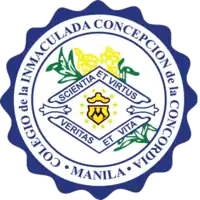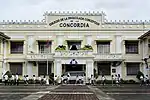Colegio de la Inmaculada Concepcion de la Concordia | |
 | |
Former names |
|
|---|---|
| Motto |
|
Motto in English |
|
| Type | Private non-profit basic and higher education institution |
| Established | May 3, 1868 |
| Founder | Margarita Roxas De Ayala |
Religious affiliation | Roman Catholic (Daughters of Charity) |
Academic affiliations | PAASCU DCSLMES |
| President | Sr. Nicetas M. Favorito, DC |
| Principal | Nereann H. Tuaño |
| Address | 1739 Pedro Gil Street , , Metro Manila , Philippines 14°34′52″N 121°00′09″E / 14.5812°N 121.0025°E |
| Alma Mater song | College Hymn |
| Patroness | Blessed Virgin Mary (Under the title Our Lady of the Immaculate Conception) |
| Colors | Blue and White |
| Website | laconcordia |
The College of the Immaculate Conception of Concordia (Spanish: Colegio de la Inmaculada Concepcion de la Concordia) commonly known as Concordia College Manila is a private Catholic basic and higher education institution run by Daughters of Charity of Saint Vincent de Paul in Paco, Manila, in the Philippines. The college was founded in 1868. The institution is affiliated with DC-SLMES (St. Louise de Marillac Educational System).
History
Colegio de la Inmaculada Concepcion de la Concordia was established by Doña Margarita Roxas de Ayala by converting her three-and-a-half-hectare villa, the La Concordia Estate in Paco, Manila, into a school. She requested eight nuns from the Daughters of Charity from Spain to come to the Philippines to administer the school. They arrived on May 3, 1868, and operated the free school or Escuela Pia. Sixty students enrolled and were taught religion, good manners, reading and writing, simple arithmetic, culture, and arts like sewing, embroidery, cooking, needlecraft and household work. The medium of instruction was Spanish.[1]
In 1868, the school officially adapted a new name, Colegio de la Inmaculada Concepcion de la Concordia, the same year that it became the Central House of the Daughters of Charity in the Philippines.[2]
Significant periods in the development of the Concordia College, such as the Philippine Revolution of 1896 and the American era, brought about education reform.
Etymology
Name
According to the student manual, the name "Concordia" means "in accord with" or "in accordance to the above"
Logo
White Easter Lily
Stands for purity in thought, word, and deed
Letter M and crown
Stands for Mary, a prominent figure in the Catholic religion, who is the patroness of the school. The crown which adorns the top of the letter represents her queenship of heaven.
Twelve stars
The twelve stars which surround symbolize the twelve apostles, which represent the disciples as a whole. "It shows Mary's role in leading people to her son, Jesus"
The colors
Blue and white are the colors which represent Mary. Blue stands for loyalty and white for purity or chastity. Green stands for perpetual growth, symbolizing the school that copes with the best and worst of times.
Notable alumni
Among its well-known former students was Sister Asuncion Ventura-Horcoma Bautista, who was the first Filipino to found an orphanage, the Asilo de Looban. Additionally, there was Maria Paz Mendoza-Guazon, the first Filipino woman doctor, who was also an educator, a writer and a feminist. Although her studies were interrupted by the Revolution, she was able to resume them when she transferred to the American School in 1901.
Other notable students were Saturnina, Soledad, and Olympia Rizal, the sisters of Philippine national hero Jose Rizal.
Gallery
 Facade
Facade Monument in front of the school
Monument in front of the school Historical marker
Historical marker U-shaped building
U-shaped building Gate
Gate
References
- ↑ "About La Concordia College". Concordia College. Archived from the original on 15 April 2015. Retrieved 9 April 2015.
- ↑ "About La Concordia College". Facebook. Retrieved 9 April 2015.
External links
 Media related to Concordia College (Manila) at Wikimedia Commons
Media related to Concordia College (Manila) at Wikimedia Commons- La Concordia College, early photo of La Concordia